Bitcoin and Ethereum
Bitcoin entered July around $62,700 and increased 3% during the month to finish at ~$64,600. The month started out rough as the Mt Gox trustee confirmed it began making repayments to some creditors, Germany continued to sell off its $3b seized Bitcoin portfolio, and the spot Bitcoin ETF flows turned negative. However, Bitcoin recovered mid-month after a failed assassination attempt on Donald Trump lifted the odds of victory for the pro-crypto Presidential candidate, and as Trump later selected Bitcoin-owning Senator JD Vance as his running mate. The remainder of the month experienced volatility with Biden dropping out of the US Presidential race and the commencement of Mt Gox-related Bitcoin disbursements by Kraken and Bitstamp weighing on prices, but Trump’s pro-crypto speech at Bitcoin 2024 and the introduction of a bill by US Senator Lummis to create a strategic Bitcoin reserve as adding support. Meanwhile, network hashrate increased ~15% during the month, while Bitcoin’s cost per transaction hit a four year low. On the news front, there continued to be new and improved products around banking (Mesh/Conio), payments rewards (Fold), stablecoins (Lightning Labs), and tokenized treasuries (Hamilton), and there were many notable L2 developments, including the first verification of a zero-knowledge proof on Bitcoin by BitcoinOS, as well as from StarkWare, Yona Network, Hemi Network, GOAT Network, and Elastos to name a few.
Ethereum, by contrast, fell during the month, dropping 6% after entering July around $3,450 and finishing at ~$3,250. While Ethereum was impacted by many of the same factors as Bitcoin, performance really began to diverge after the launch of the US spot Ethereum ETFs on July 23rd as larger than expected outflows from Grayscale’s Ethereum Trust (ETHE) brought total flows negative. In addition, the ETH supply increased by ~62,000 ETH during the month, equivalent to 0.6% annual inflation, as the number of ETH issued outpace the number burned, and this occurred even as the number of transactions on Ethereum and its L2s continued to rise given the continued shift to L2s and in the wake of the Dencun upgrade. Elsewhere, the Ethereum community gathered for a successful EthCC in Brussels, highlighted by Vitalik’s keynote speech discussing improvement opportunities for Ethereum, while Vitalik also opined ways to improve confirmation speeds and circle STARKs in separate blog posts. Importantly, Beaverbuild.org, which has built roughly half of all Ethereum blocks recently, stopped censoring prohibited transactions, bringing the percentage of censoring builders to below 15%. Finally, there were a number of notable developments out of the L2s, such as: Arbitrum introduced its Timeboost proposal to capture MEV and voted to deploy Orbit chains beyond Ethereum; Polygon released its new zero-knowledge proving system Plonky3; ZKsync unveiled its ecosystem of interconnected rollups called the Elastic Chain; Base launched fault proofs on Base testnet; SVM-powered Eclipse launched its mainnet for developers; and, Celo launched its Dango Layer 2 testnet as it transforms into an Ethereum L2.
BTC and ETH
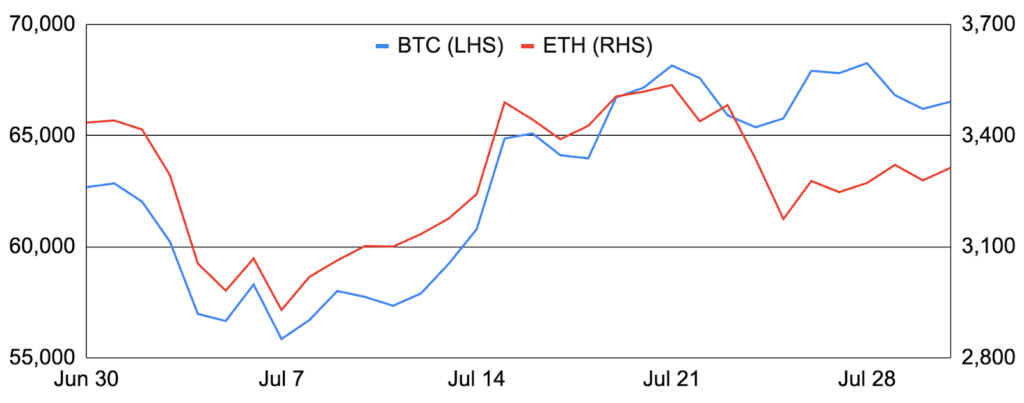
Source: Santiment, GSR.
The Spot Ethereum ETFs Launch
After approving the 19b-4 filings in May, the SEC spent most of July going back and forth with the issuers regarding their S-1 registration statements, with few notable items except for the fees. While most issuers instituted fee waivers and clustered around the 19-25 bps fee rate range, Grayscale, which converted its $10.2b Ethereum Trust (ETHE) into an ETF, elected to maintain its 2.50% fee on ETHE while simultaneously spinning out 10% of the fund into a new Mini Trust ETF (ETH) that would charge a category-leading 15 bps. Such a strategy enables Grayscale to continue to capture ETHE’s high fee for holders who wish to remain in the fund due to a low tax basis or are not fee sensitive but also provides holders with a place to go for those who want a competitive fee and gives Grayscale a chance at capturing new AUM that comes into the space, especially given the Mini Trust’s low fees and its considerable initial AUM lead over peers at $1.1b.
Regardless, the SEC granted final approval of the spot Ethereum ETFs after several rounds of amendments, and they began trading on July 23rd to a strong debut. Indeed, launch day saw the new ETFs gather $107m of first day net inflows and experience nearly $1.1b in trading volume. Under the hood, however, Grayscale’s ETHE lost $484m, or 5.2% of its AUM, and though inflows into the other funds more than made up for ETHE’s outflows, day one flows also included pre-arranged flows such as Bitwise’s disclosed $100m of AUM from Pantera, and also likely benefited from inflows from the spot Bitcoin ETFs. Such was a sign of things to come, as the absence or lower extent of these two items and continued heavy ETHE outflows caused total flows to move negative for the subsequent four trading days. Though this was somewhat predictable after watching the spot Bitcoin ETFs experience negative inflows in six of their first ten trading days for the exact same reason, the size and timing of the ETHE outflows appears to have caught many by surprise and caused Ethereum’s price to materially diverge from Bitcoin’s. Observers will continue to closely watch the size and pace of ETHE outflows and whether the other ETFs can continue to generate solid inflows in a choppy market, though ETHE outflows have been moving down and many are hopeful the funds overall will see consistent net positive flows that will support ETH’s price. Even more so, however, the launch of the spot Ethereum ETFs represents a milestone for Ethereum, not only giving investors access in a convenient and familiar vehicle but also cementing digital assets beyond just Bitcoin as a true asset class.
Spot Ethereum ETF Inflows, $m
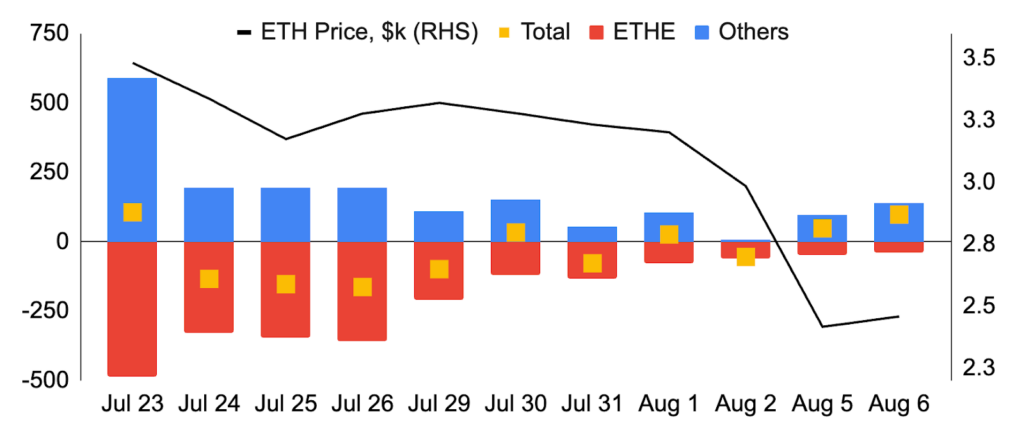
Source: FarsideUK, GSR.
Mt Gox Disbursements Commence
Also causing consternation (prior to the event), but coming with the large silver lining of limited selling was the commencement of the return of Bitcoin and Bitcoin Cash to Mt Gox creditors during the month. Recall that the Mt Gox trustee previously announced disbursements would begin in July through five different exchanges, and it confirmed this to be the case at the beginning of the month. First up was Kraken, which received an estimated $3.1b of BTC on July 16th, which it then successfully distributed to creditors on July 23rd. Not only was the return of the funds a seminal event, marking the completion of a process that began a decade earlier, but it also occurred with no discernable short-term impact on Bitcoin’s price, indicating that creditors were not selling en masse as some had feared. And just a few days later, Bitstamp successfully returned Bitcoin to additional Mt Gox creditors, also without a noticeable impact on price. More recently, Mt Gox sent an estimated $2.2b of BTC to a wallet Arkham believes is likely owned by BitGo, though BitGo has neither confirmed nor denied this information, nor has it made any subsequent announcements regarding the return of funds. As it stands, Mt Gox wallets currently hold ~46,000 BTC, down from 142,000 prior to the process beginning. And if recent history (or insightful analyses by CoinShares and Galaxy) is any guide, creditors may continue to HODL as the remaining funds are disbursed, with Mt Gox perhaps even acting as a positive catalyst as one of the largest and longest-standing overhangs in crypto is removed.
Mt Gox Bitcoin Holdings
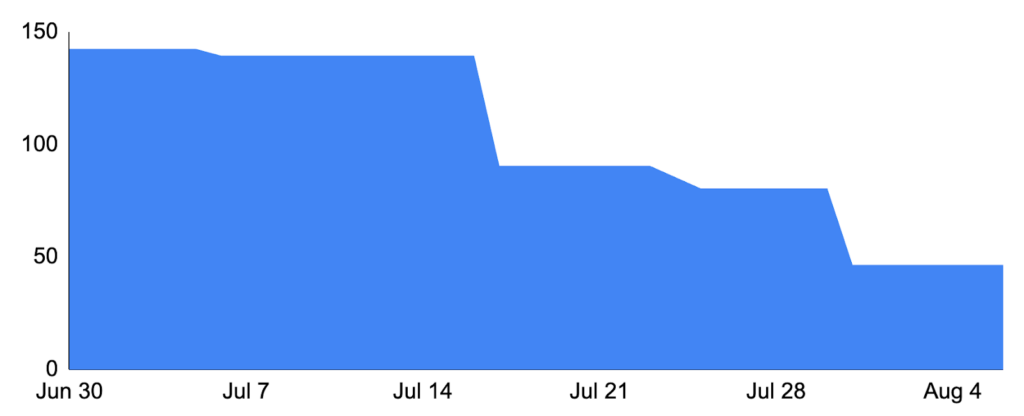
Source: Arkham, GSR.
US Politicians Embrace Crypto Amidst a Wild Month
It was a wild month for US politics, with large implications for crypto. The month started off with calls by prominent US lawmakers and political donors for sitting US President Joe Biden to withdraw as the presumptive Democratic nominee after a poor debate performance at the end of June that left many questioning his mental fitness. Meanwhile, Trump continued to escalate his pro-crypto promises by featuring crypto in the Republican party platform and signing up as the keynote speaker at Bitcoin 2024. The month suddenly got crazier after a shooter inexplicably was able to fire shots at Trump during a rally in Pennsylvania on July 13th, with the incident seen by some as increasing the odds that Trump, who is generally perceived as the more crypto-friendly candidate, will take the White House. Indeed, Trump’s odds of winning the Presidential election in November increased from 60% to 70% on Polymarket in the wake of the event, and Trump received several notable endorsements shortly after, such as from Elon Musk. And just a few days later, Trump picked Ohio Senator JD Vance to be his running mate. The choice was generally seen as positive for crypto, as Vance holds a favorable view of the industry, was working on a crypto-friendly bill to regulate the industry, and has criticized the SEC, particularly with regards to the DEBT Box case.
The race for the Presidency was again rocked when President Biden heeded calls and dropped out of the Presidential race on July 21. Crypto prices fell in the wake of Biden’s announcement as the market viewed alternative candidates, where it soon became clear that Vice President Kamala Harris would be the Democratic nominee, as having a better chance at winning against Trump. Regardless, while some have lumped Harris in with the current Administration’s less-than-friendly views toward crypto, others believe Harris has had little influence on the current Administration’s stance, which has been outsourced to Elizabeth Warren, and noted that it’s unsurprising Harris doesn’t have well-formed views as she was just dropped in this position rather than having the customary 1-2 years to organize her campaign, that the former Senator from California always had a productive relationship with tech companies, and as her campaign has reached out to influential individuals and companies within the industry to discuss crypto policy.
The month concluded with Donald Trump’s extremely pro-crypto keynote speech at Bitcoin 2024, where he promised to establish a US strategic Bitcoin reserve, immediately fire SEC Chair Gensler, and clarify crypto regulation within 100 days of taking office. In typical Trump fashion, the speech was somewhat rambling and stream of consciousness and it is unclear how many of his promises will come to fruition should Trump be elected, but the speech included just about everything on the industry’s collective wish list. Finally and at the same conference, US Senator Lummis revealed plans for a bill that would establish the strategic Bitcoin reserve and direct the government to purchase 1m BTC, or ~5% of supply over time.
Senator Lummis’s Proposed BITCOIN Act
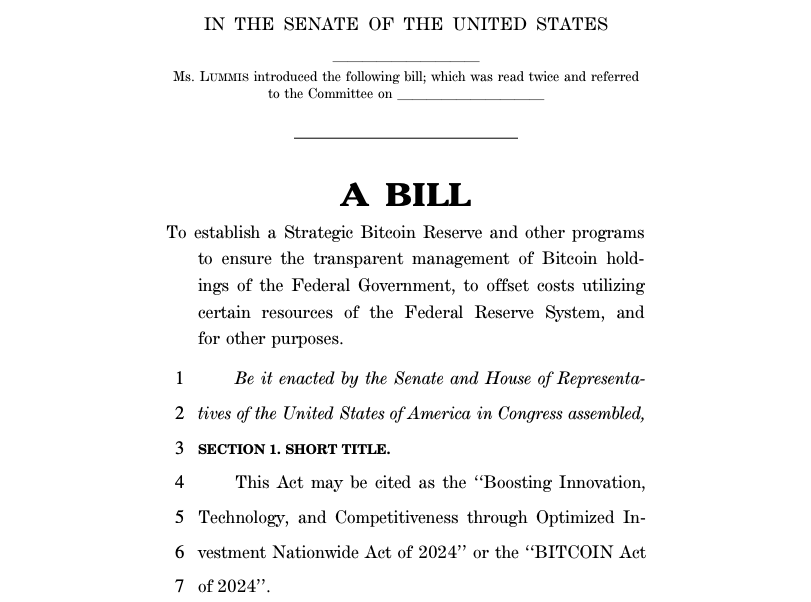
Source: Senate.gov, GSR.
Polymarket’s Ascent
One final particularly notable item during the month was the steep ascent of Polymarket, a decentralized predictions market platform that allows users to place bets on a wide range of topics like sports, politics, and pop culture. With its sleek UI/UX making it easy to use for crypto degens and normies alike, and betting markets ranging from who will win the US Presidential election, where over $500m of bets are currently placed, to which country will win the most Olympic gold medals to whether Taylor Swift will get engaged this year, Polymarket has burst onto the scene to become the world’s largest prediction market. Further, Polymarket uses a specialized binary markets exchange contract, where the price of a bet represents the market-implied odds of it happening, users can exit positions at any time to limit losses or capture gains, and bets will resolve to $1.00 should the event occur and $0.00 otherwise. For example, it currently costs $0.82 to wager that Biden will finish his current term as President, implying that the market believes Biden has an 82% chance of doing so, and a user could enter into such a bet by paying $0.82, may sell the position at any time at the going market price, or can hold onto the position through the end of the bet to make $1.00 if Biden does indeed finish his term or lose the money wagered if not. Finally, while US users are geo-blocked and Polymarket is focused on garnering repeated and frequent usage after the election season ends, predictions markets have proven to be more accurate than surveys and expert opinions, resulting in many using the site not only to place bets, but also as an information source that is perhaps more accurate and timely than others. All in, Polymarket has found true product-market fit to capture the attention of millions, serve as a reliable information barometer across myriad key topics, and continues to see skyrocketing growth.
Polymarket Monthly Volumes, $m
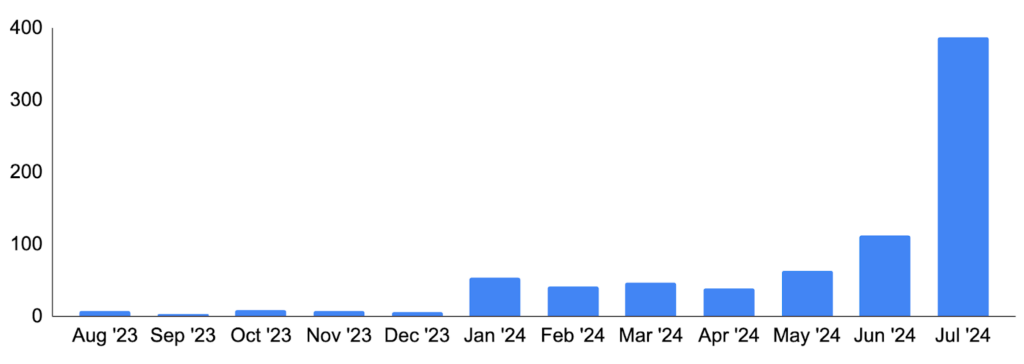
Source: Dune @rchen8, GSR.
GSR in the News
- Bloomberg – Crypto ‘Trump Trade’ on Hold as Other Factors Captivate Market (BTC, ETH)
- CoinDesk – GSR and Wealth Manager St. Gotthard Execute Options Trade Tied to CoinDesk 20 Index
- Bloomberg – Bitcoin (BTC) Hits Six-Week High in Wake of Trump’s Pro-Crypto Speech
- CryptoGlobe – Ethereum Products Face $61M Outflows, While Solana Sees $1.6M Inflows Amid Broader Crypto Market Decline
- Blockworks – The Trump Effect
- The Block – Despite Mt Gox sell-off, market makers and investors are cautiously optimistic on BTC
- Blockworks – How Biden ending his re-election campaign could impact bitcoin
- Decrypt – Bitcoin Spikes as Failed Assassination Attempt Bolsters Trump’s Election Bid
- The Block – Bitcoin scaling network Mezo raises $7.5 million in new funding
- Bloomberg – Major Tokens Claw Back Losses as Ether ETF Investors Buy Dip
- Bloomberg – ‘It Hurts Confidence:’ Volatility Upends Happy Crypto Narrative
- The Block – WATCH LIVE: Experts discuss the crypto market crash on The Crypto Beat
- Decrypt – Why the US’s $35 Trillion National Debt is ‘Good for Bitcoin’
Author:
Brian Rudick, Senior Strategist | Twitter, Telegram, LinkedIn
This material is provided by GSR (the “Firm”) solely for informational purposes, is intended only for sophisticated, institutional investors and does not constitute an offer or commitment, a solicitation of an offer or commitment, or any advice or recommendation, to enter into or conclude any transaction (whether on the terms shown or otherwise), or to provide investment services in any state or country where such an offer or solicitation or provision would be illegal. The Firm is not and does not act as an advisor or fiduciary in providing this material. GSR is not authorised or regulated in the UK by the Financial Conduct Authority. The protections provided by the UK regulatory system will not be available to you. Specifically, information provided herein is intended for institutional persons only and is not suitable for retail persons in the United Kingdom, and no solicitation or recommendation is being made to you in regards to any products or services. This material is not a research report, and not subject to any of the independence and disclosure standards applicable to research reports prepared pursuant to FINRA or CFTC research rules. This material is not independent of the Firm’s proprietary interests, which may conflict with the interests of any counterparty of the Firm. The Firm trades instruments discussed in this material for its own account, may trade contrary to the views expressed in this material and may have positions in other related instruments.Information contained herein is based on sources considered to be reliable, but is not guaranteed to be accurate or complete. Any opinions or estimates expressed herein reflect a judgment made by the author(s) as of the date of publication, and are subject to change without notice. Trading and investing in digital assets involves significant risks including price volatility and illiquidity and may not be suitable for all investors. The Firm is not liable whatsoever for any direct or consequential loss arising from the use of this material. Copyright of this material belongs to GSR. Neither this material nor any copy thereof may be taken, reproduced or redistributed, directly or indirectly, without prior written permission of GSR.
